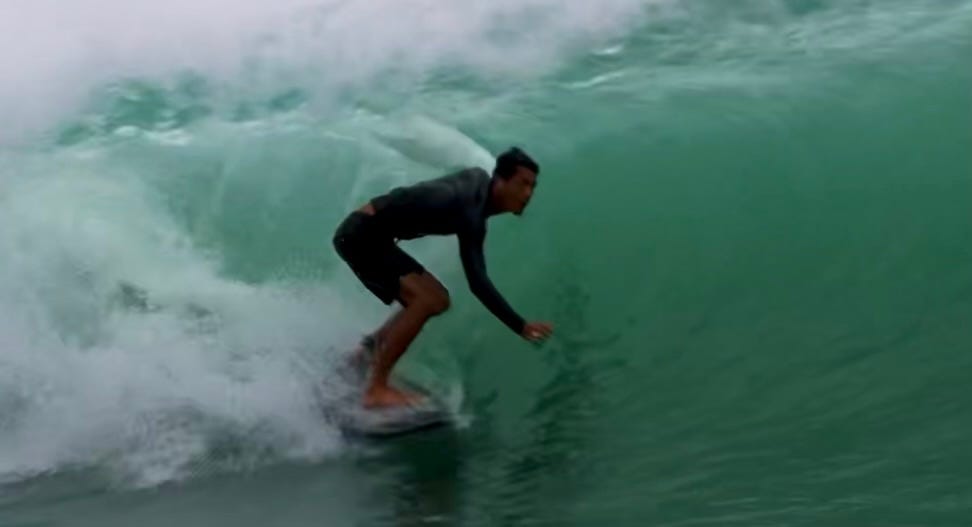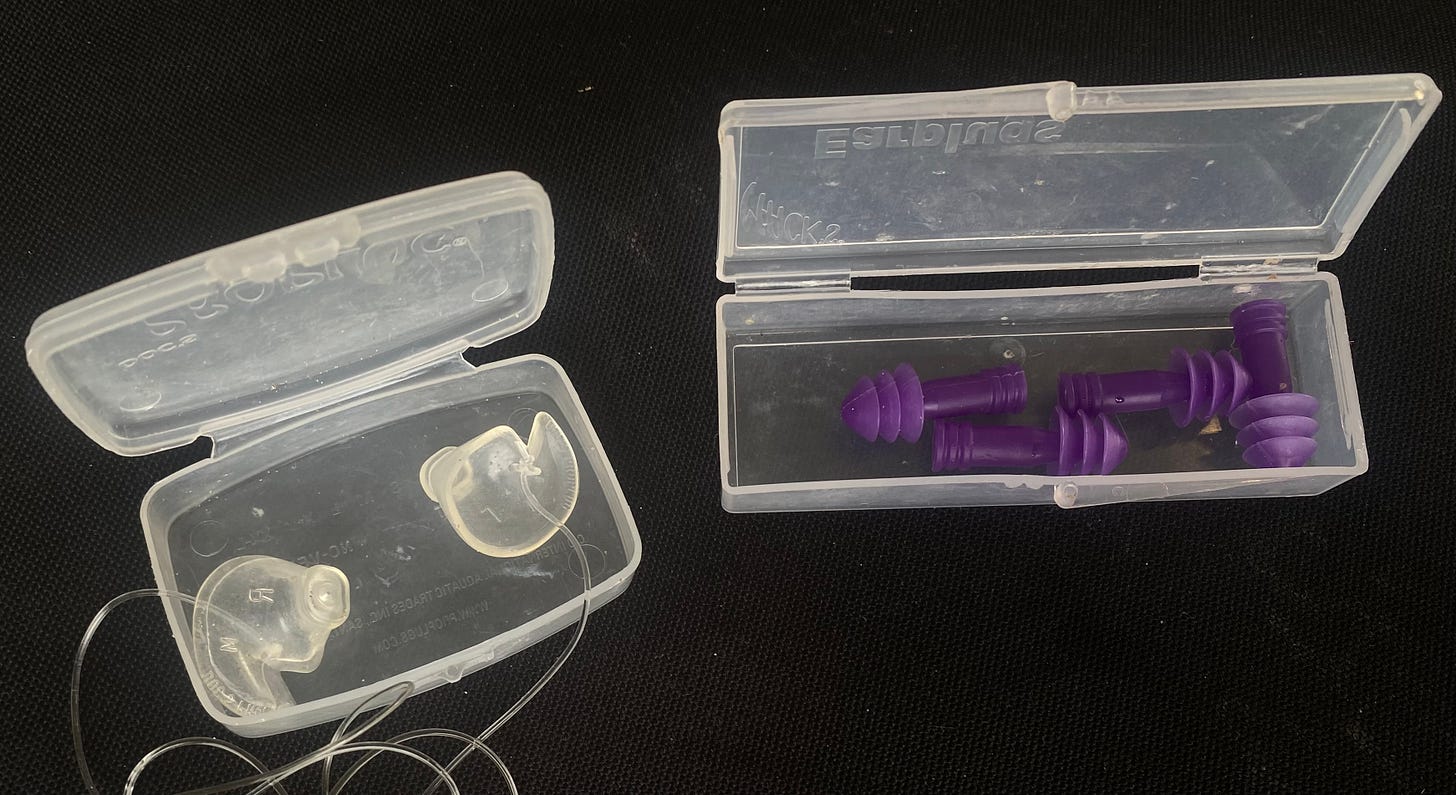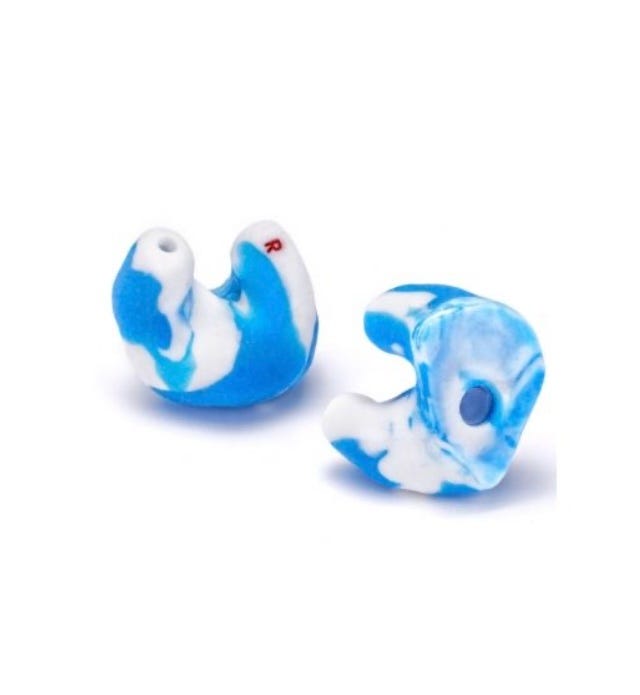The comprehensive guide to avoiding surfers ear surgery
I did the research so you don’t have to.
Photo: AI image generator
I have surfers ear, and I’ll need surgery for it pretty soon. As my ears have gotten worse recently, I’ve been ramping up my efforts to stave off the inevitable surgery. Any investment of time or money will pay off if I can delay the surgery even a little bit. According to my doctors, my ears are 80% closed on my right side and 60% on my left. I am 25 years old, and have been surfing, swimming, and diving in the ocean consistently since I was 10. The water where I live is temperate, and ranges from 55-65F, 12.8-18.3C. I've been aware of my surfer’s ear problem for about the last 5 years, when I started leaving the water with aching pains coming from my inner ears. That’s when I started wearing plugs, and where this whole journey began. So, I’ve compiled a list of products and strategies that I’ve tried so that hopefully I can help out a fellow lord or lady.
Surfer's ear, or exostosis, is the growth of the bones in the inner ear, caused by repeated exposure to cold water and wind. The wind is usually more of a driving force, since it makes your ears more cold than just water alone. For example, the prevailing wind where I live blows from right to left if you're staring at the horizon waiting for a set, and that’s the reason my right ear is about 20% more closed than my left. It’s a gradual accretion, or piling up of bone in the ear canal that creates a narrower passage for water to enter, and more importantly exit your ears. Water trapped in your inner ear impedes hearing and leads to infections. If your ears have slight evidence of bony growths, but infections aren’t happening, then you’re fine, for now. The problem is that this bone growth is consistent—it doesn’t occur as a result of a single or a few exposures, rather once it starts it continues consistently, gradually, constantly. This means that if you have a mild case now, but you don’t make an effort to curb the growths, you’ll end up getting worse. Slowing the growth is the name of the game here, and there’s 2 good ways of doing it. First, keep your ears dry while you surf by using some sort of plug. Second, remove any lingering water from your ears after your session to prevent infection and discomfort. So, if you want to prolong the health of your ears, have a look at some of the things I’ve tried and feel free to discuss your own experience in the comments.
To stay dry in the surf
Beginner: Silicone
If you think I’m here to hawk my personal brand of ear plugs at you then I’m sorry, because I’m way too honest to be a salesman. For 90% of you out there, the best, and by that I mean simplest, easiest and cheapest thing you can use is silicone earplugs. They’re available for cheap at pretty much any drugstore in the world because they’re supposed to be used for blocking out noise while sleeping. Buy a pack of 12 for like 6$, pop one in each ear and go shred. Easy. They’ll keep your ears dry while being relatively comfortable. The drawbacks are, of course, that they’re designed to cut out noise, so if anyone talks to you during your session you’ll have to pull them out and ask them to repeat themselves. (Not a bad excuse if you want to burn someone though) Also, after a few uses they lose their stickiness and can get kinda grimy, so they will either fall out in the surf, or you’ll just want to go back into that 12-pack and grab a couple fresh ones. Either way, the back of your car will be littered with nasty putty and containers if you choose to stick with them long enough.
Just because you run entry level ear gear doesn’t mean you’re a beginner surfer. Eros Surya agrees.
Intermediate: Mack’s plugs, docs plugs, hearos, etc.
https://www.macksearplugs.com/product-category/swimming-ear-plugs/
https://www.proplugs.com
Mack’s on the right, Doc’s on the left.
Walk up to the cash register at your local surf shop and peer downward, through the glass countertop. Somewhere in the shelves above the sunglasses and in front of the stickers will be baggies of earplugs that look like they were left over from the 90s. They are made specifically for ear protection, whether that’s swimming, surfing, or on a work site, and occupy the middle tier of ear protection in terms of quality, price, durability and comfort. I’ve tried just about every brand and style of these that I’ve ever seen and they all go pretty similarly. They usually fit awkwardly, but do a decent enough job of keeping the water out. They have been designed to allow some hearing as well, so you won’t be screaming to your buddy next to you either. Their demise, every time, happens when one of them pops out in the water and is gone forever. They’re often sold without replacements or a string, so the single plug by itself is useless. My only exception was a pair of Mack’s plugs that came with a string that I could tuck into my wetsuit that worked great, and lasted for almost a year until I left them sitting on my board and forgot about them, then picked the board up and walked away. Darn shame. If you’re looking to spend 20-30$ on some ok hardware that’s been designed for your specific purposes, I’d go with Mack’s plugs of some kind. They have a range of materials and models and seem to invest a bit more into r and d. Most surf shops will carry them as well.
Advanced: SurfEars
https://surfears.com
Surfer-made and marketed, SurfEars are a cut above the rest of the market in terms of quality, so the higher price tag is justified. Whoever designed them clearly put some thought into it, and created a simple and effective system of interchangeable parts that do the best job of keeping water out of your ears and still letting you hear, while also being pretty comfortable. They come in a sleek pouch that you can attach to your keys, and even include a rubbery tether that will prevent you from losing one if it comes out of your ear, plus different sized rubber rings to get the right fit in your ears. They're not perfect, though. You will have to continuously adjust and readjust the plugs while they're in your ear to get the right seal. I often find myself pushing them back in right before a duckdive. Also, the tether can be a double edged sword. If you tuck it into your wetsuit, or even just tighten it behind your neck, it can get stuck when you turn your head and the tension from one side of the string will yank one of the plugs right out. Annoying. Give yourself some slack with it. The biggest problem with surfears, though, is their durability. I've owned 2 pairs, and each has lasted less than 6 months before the exact same problem renders them useless: the membrane that keeps water out but lets noise in--the crux of the entire product-- eventually fails. This membrane is essentially a sticker, and after some use, the adhesive fails and the sticker unpeels, letting in water. The only solution to this is to buy a new center piece, which is where the membrane sticker is. Luckily, you don't have to buy the full package to get a new one, SurfEars sells replacement center pieces for $9 each. So, Surfears are higher quality, but not cheap and it’s slightly frustrating that the extra investment doesn't guarantee you long lasting quality. I would still highly recommend them, and if you don't feel like listening to me then you can take it from Tom Carroll
My set of SurfEars after a few months of heavy use. Note the grey membrane sticker unpeeling.
Pro:Westone Surf Plugs
https://westone.com/defendear/defendear-recreational/surfer
After being frustrated by all the other options on the market, I decided to go all out and spend the 300$ at the audiologist to get fitted for custom plugs. Most audiologists will be able to do this for you, or will refer you to someone who can. The process is really easy, one short appointment for making the mold of your ears and choosing the specifics of your customs, and then another to make sure they fit. They feature a similar design to the SurfEars, where a membrane seals out water, but allows sound to pass through. They are different from SurfEars because they’re made of solid, yet squishy rubber. The only drawbacks are that its 300$, and that the company who makes the plugs, Westone, dont surf. By this I just mean they aren’t out testing them at your local beach. Additionally, they seem to have the market cornered in this area so they don't have much incentive to improve their product. This said, I’m extremely satisfied with mine. They take a second to get used to because they fit tightly and involve some work to get them into place, but once they’re set, they’re not coming out. Compared to SurfEars, your hearing will be worse but your ears will be much more sealed from water. Also, they won't threaten to fall out even on hard wipeouts. A little water will trickle in, but if they fit right, water shouldn’t make it into your inner ear. They come with a string but it's not totally necessary, and is admittedly, poorly designed. The major positive and the only reason they can demand such a silly sum is the quality of the custom molds, and presumably the hours required by an expert to create those molds. That seems to be the key to a long-lasting quality seal.
Hoods
Hood up or shut up.
You ever wonder how people can surf their whole lives in frigid water and never have ear problems? Hoods are how. This is the most common and most obvious method of ear protection, so I won't labor on. Simple, tried and true, effective.The water where I live is not cold enough to justify a hood most of the time, so I’m not able to use it as a long term or everyday solution for myself. That said, if you can wear one every session, you should. It doesn't matter if a little water gets in when you duckdive, the important thing is that it keeps your ears warm, and blocks the wind from cutting in. Mix in one of the plug options above for maximum, AAA+ ear protection. Just make sure they’re comfy in your ears with the extra pressure the hood will put on them.
Water removal solutions
After your session, even if you're using one of the plug options above, you may find you have a little extra water rattling around in your ears. If your growths are as bad as mine, pretty much any time you dunk your head under, water will get trapped behind the bony outcrops and need to be emptied out later on land. It's important to do so, as having water trapped in your ears can lead to infections or worsening of the surfers ear growths, plus its really annoying. I've tested out a few different ways to get rid of this nuisance moisture, so here they are.
Beginner: Rubbing Alcohol
Fits into the same category as the silicone plugs above—cheap and easy to find, the best option for most people. You probably already have a bottle in your bathroom somewhere, so add dumping very carefully into your ears after surfing to its list of uses. Alcohol helps speed up the evaporation of water by disrupting water’s surface tension, so this is a no BS, effective way of getting rid of water. I stopped doing it because it would occasionally give me sharp pains in my ears and jaw afterwards.
Intermediate: Big Wave Drops
https://bigwavedrops.surf
How much is in the BigWave bottle? You tell me. 1 liter bottle for scale.
Great product. It's just alcohol with some essential oils and other natural ingredients to soften it up, so it works on the same principles as isopropyl, but doesnt feel as harsh. Very useful for getting rid of water and keeping your ears clean and infection-free. The convenient dropper makes it easy to use and the small bottle makes it more portable for traveling. Buy online for 25$ for a small bottle, it ships from San Francisco, USA. The website will not tell you the volume of this bottle, and I’m far too American to be estimating anything in mL. What I can tell you is that it's not very big, but should be plenty to last you for at least a whole surf season.
Also intermediate: Mack’s ear dryer
“Hello?”
https://www.macksearplugs.com/product/ear-dryer/
I was not aware of the existence of this thing until I got onto the topic of plugs with a local lord during a recent crowded session. He told me he uses something that looks like an old telephone and blows warm air into his ears to dry them out after he surfs. I looked online and found many different styles of the same product, most of them made by non surf companies, and decided on the one that was made by our old friend Mack’s. You load it up some AAA batts, push one button, and it whirs warm air into your soggy canals. I haven’t used it much, but I can imagine in the cold wintertime it will feel really nice. If you’re really serious, using the dryer after the alcohol or big wave drops would ensure maximum dryness and comfort with a minimum poking of a towel into your ears to mop up the last of the liquid.
So that’s it. Try these out, keep your ears dry, and let me know how they work out for you. If there’s anything I missed I would love to know about it as well. Thanks,
LG











